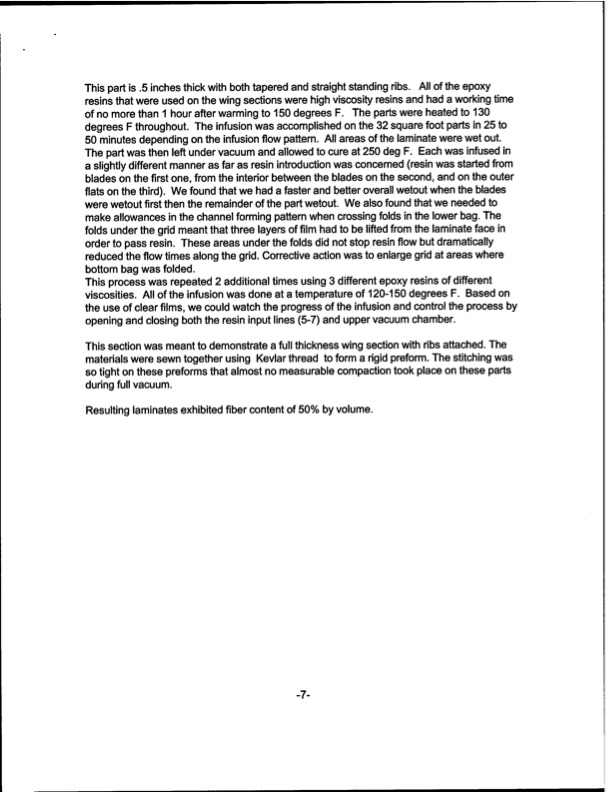
PDF Publication Title:
Text from PDF Page: 008
This part is .5 inches thick with both tapered and straight standing ribs. All of the epoxy resins that were used on the wing sections were high viscosity resins and had a working time of no more than 1 hour after warming to 150 degrees F. The parts were heated to 130 degrees F throughout. The infusion was accomplished on the 32 square foot parts in 25 to 50 minutes depending on the infusion flow pattern. All areas of the laminate were wet out. The part was then left under vacuum and allowed to cure at 250 deg F. Each was infused in a slightly different manner as far as resin introduction was concerned (resin was started from blades on the first one, from the interior between the blades on the second, and on the outer flatsonthethird). Wefoundthatwehadafasterandbetteroverallwetoutwhentheblades werewetoutfirstthentheremainderofthepartwetout. Wealsofoundthatweneededto make allowances in the channel forming pattern when crossing folds in the lower bag. The folds under the grid meant that three layers of film had to be lifted from the laminate face in order to pass resin. These areas under the folds did not stop resin flow but dramatically reduced the flow times along the grid. Corrective action was to enlarge grid at areas where bottom bag was folded. This process was repeated 2 additional times using 3 different epoxy resins of different viscosities. All of the infusion was done at a temperature of 120-150 degrees F. Based on the use of clear films, we could watch the progress of the infusion and control the process by opening and closing both the resin input lines (5-7) and upper vacuum chamber. This section was meant to demonstrate a full thickness wing section with ribs attached. The materials were sewn together using Kevlar thread to form a rigid preform. The stitching was so tight on these preforms that almost no measurable compaction took place on these parts during full vacuum. Resulting laminates exhibited fiber content of 50% by volume.PDF Image | Affordable NDM Vacuum Assisted Resin Transfer Molding

PDF Search Title:
Affordable NDM Vacuum Assisted Resin Transfer MoldingOriginal File Name Searched:
ADA373442.pdfDIY PDF Search: Google It | Yahoo | Bing
5,000 BF Shipping Container Lumber Dry Kiln For Quality Lumber The 5,000 BF container kiln consists of one 40 foot high-cube aluminum shipping container... More Info
Shipping Container Lumber Dry Kilns by Global Energy Global Energy designed and developed the container kiln back in 1991. The purpose is to give access to portable sawmill owners, furniture makers, and small business the value added profit of dry kiln lumber and quality hardwoods... More Info
Vacuum Kiln Conversion Kit for Lumber and Wood Dry Kilns Convert your existing conventional dry kiln into a fast drying vacuum kiln. Similar to vacuum bagging in the boat building and aircraft industry, we have come up with a proprietary process which allows you to build a very simple vacuum kiln at a fraction of the price, and without the intensive conventional metal chamber structure... More Info
Vacuum Pump Cart System for Bagging Clamping Wood Drying and more Vacuum Cart with 2HP Pump and Dual Pistons with multiple multiplex vacuum ports and liquid reservoir... More Info
Vacuum Bagging Basics Vacuum bagging is a method of clamping, which has traditionally been used in the composites industry, but can also be used for vacuum drying materials, including wood products... More Info
| CONTACT TEL: 608-238-6001 Email: greg@globalmicroturbine.com | RSS | AMP |